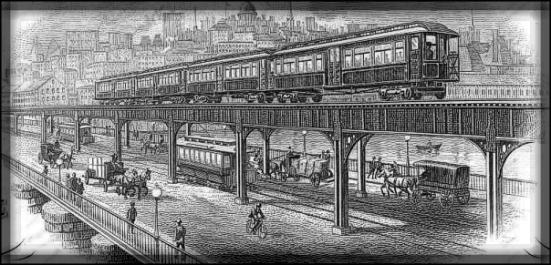Beautifully engraved Certificate from the Boston Elevated Railway Company issued no later than 1915. This historic document was printed by the American Banknote Company and has an ornate border around it with a vignette of the elevated railroad in Boston with horse drawn carriages below. This item is hand signed by the company's officers and is over 90 years old. 
Certificate Vignette On July 2, 1894, the Massachusetts Legislature authorized the incorporation of the Boston Elevated Railway Company (BERY) and creation of the Boston Transit Commission. The Boston Elevated Railway Company was to be privately owned and was delegated the responsibility of building a network of various suburban elevated railway lines. The Transit Commission was to be a government agency whose main existence would concentrate on the Transit Commission's reccomendations for additional subway extensions. Initially, the Boston Elevated Railway as a private company experienced difficulty raising necessary capital. By this time, though, the West End Street Railway was in difficulty. It had a virtual monopoly on all streetcar lines in greater Boston, but high profits, poor service, high fares and a general lack of concern for the public had resulted in alienation of the West End's management from its customers. On December 9, 1897, under the supervision of the Transit Commission, a lease was entered into with the West End Street Railway by which the property of that company was leased to the Boston Elevated Railway Company for a term of twenty-four years, eight months and nine days from October 1, 1897. Because of legalities, lease requirements, stock negotiations and ratifications by various parties, the Boston Elevated Railway did not finally take possession until December 30, 1897. This soon proved to be advantageous to the future of the mass transportation system here in Boston. Subway/elevated rapid transit lines were integrated with surface routes under one coordinated management. But before this could become a fait accompli, a bitter proxy battle took place. J.P. Morgan had purchased the Boston Elevated Railway's franchise assigning 50% interest to Kidder, Peabody, and Company. If the Boston Elevated Railway was to be profitable, all surface and rapid transit lines had to be unified. But the West End management, use to high profits and dividends, was not about to be absorbed by anyone. Nonetheless, at a November 24, 1896 West End annual meeting, a proxy battle took place and the Boston Elevated Railway came out the winner. During the next four decades the mass transportation system in Boston experienced tremendous physical expansion. New rapid transit tunnels were constructed, elevated railway lines were thrust out into outlying communities, new surface routes were established, and new carhouses and terminals were built.

Certificate Vignette








